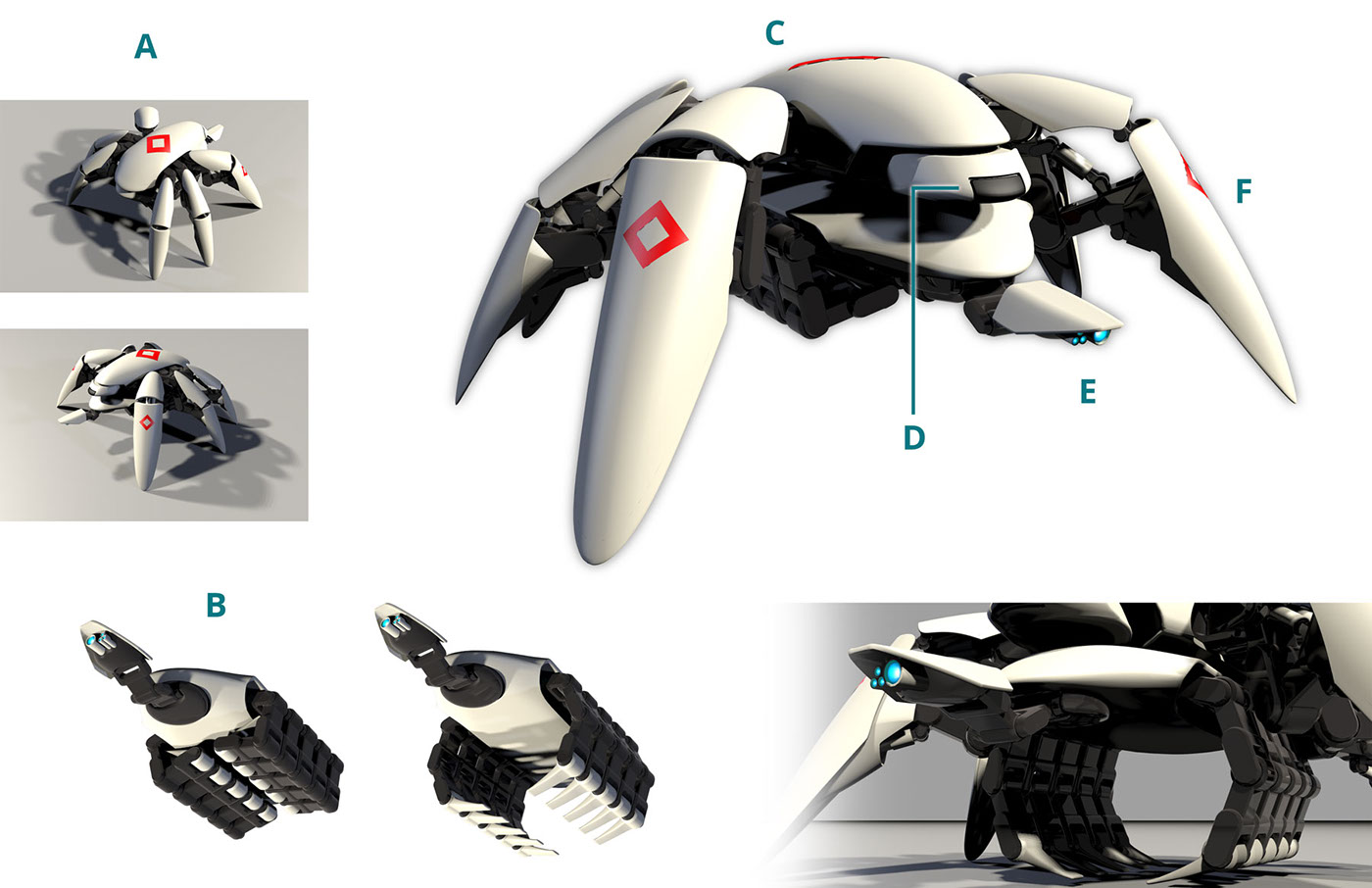Able to autonomously distinguish living human beings from inanimate objects, Elios is meant to scout terrain, locate vicims of natural disaster or warfare, and bring them to safety.


A: Peaceful, humanitarian symbols clearly recognizable, from above as well as from ground level
B: Once in position over victim, the lower portion of the bot deploys its lifting arms, positioning them beneath the victim. The arms then retract, lifting the victim for transport. During operation, the arms are surrounded by soft material and durable cloth cover for a safe ride.
C: Upper body houses engine and machinery
D: Navigation hub contains sensors for navigating complex terrain
E: 'Head" contains multiple optic sensors for distinguishing between humans and inanimate objects
F: Damage-resistant armor plates protect leg machinery beneath
B: Once in position over victim, the lower portion of the bot deploys its lifting arms, positioning them beneath the victim. The arms then retract, lifting the victim for transport. During operation, the arms are surrounded by soft material and durable cloth cover for a safe ride.
C: Upper body houses engine and machinery
D: Navigation hub contains sensors for navigating complex terrain
E: 'Head" contains multiple optic sensors for distinguishing between humans and inanimate objects
F: Damage-resistant armor plates protect leg machinery beneath

Research & Ideation: Trashbots
A variety of possibilities for a robot that would reside in a junkyard, moving steadily through it, collecting and sorting trash to be sent for further processing. Most were some variation of an automated vehicle with legs for movement and arms to collect trash, which was then placed on a conveyor belt.
Scoutbots
Ideally, scoutbots would be able to cover large amounts of terrain over a short time, searching for victims whose location would be sent to a rescue team. Most were some kind of variation of a flying vehicle with cameras for reconnaissance.

Firebots
These were conceptualized as supplements to firefighting teams. Ideally, they would be able to autonomously search out weak points in a fire from the outside of the burning structure, and aim blasts of water where they would be most effective, thus freeing firefighters for other tasks.
These ideas eventually morphed into the final project area chosen: the Rescuebot. This arose from a desire to allow the Firebots to not only combat fire, but to enter buildings and rescue victims as well by allowing people to climb inside of the vehicle.
These ideas eventually morphed into the final project area chosen: the Rescuebot. This arose from a desire to allow the Firebots to not only combat fire, but to enter buildings and rescue victims as well by allowing people to climb inside of the vehicle.
Development: Rescuebots
The final concept chosen was to be a robot that would be able to rescue victims of natural disasters or warfare, bringing them away from the hazardous area to safety. Originally the ability to fit inside buildings was a priority, but this was dropped early on due to the difficulties presented in creating a robot both able to carry people and fit through a doorway. Eventually the battlefield was chosen to be the robot’s prime habitat, and rescuing wounded soldiers or civilians its primary goal.

The 3D model went through several stages before reaching completion. Earlier versions included harder edges and more complicated mechanisms for lifting disaster victims - arguably much more potentially dangerous to the rescuee.
A large part of the original design was a compartment wherein the victim would reside during transportation to safety. This added container proved too complex and made the robot much larger and bulkier than necessary, and was dropped later on.
A large part of the original design was a compartment wherein the victim would reside during transportation to safety. This added container proved too complex and made the robot much larger and bulkier than necessary, and was dropped later on.
3D Model

